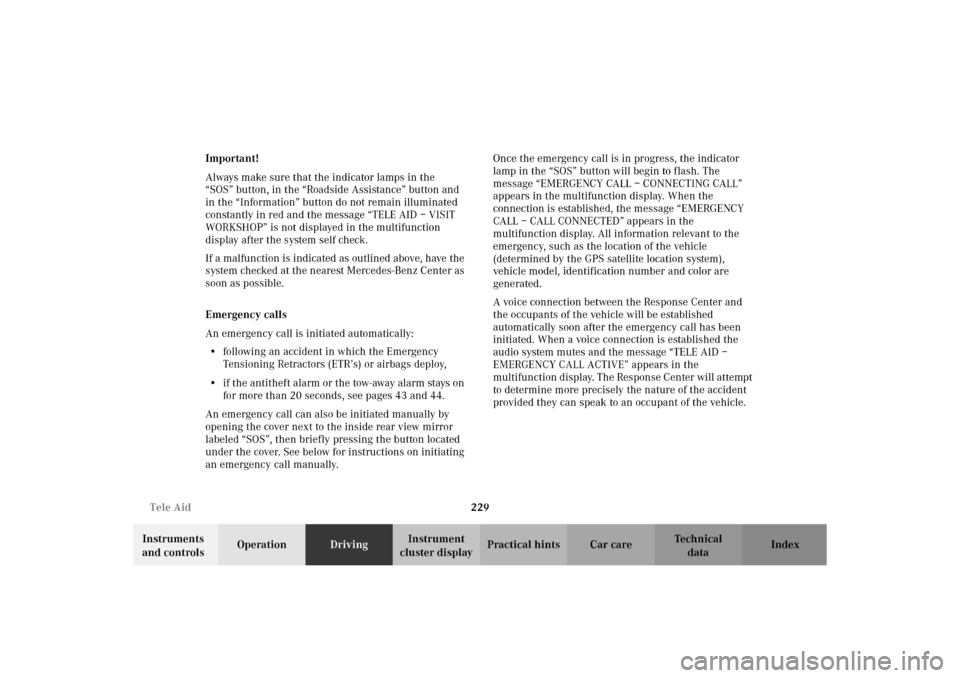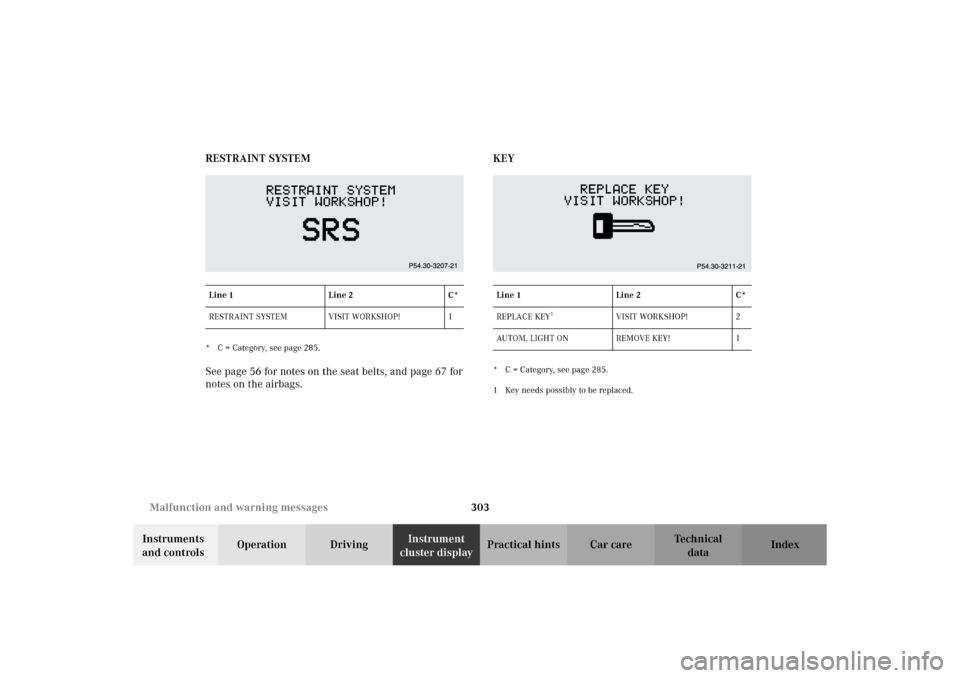2002 MERCEDES-BENZ C320 WAGON airbag
[x] Cancel search: airbagPage 150 of 390

147 Hazard warning flasher
Te ch n i c a l
data Instruments
and controlsOperationDrivingInstrument
cluster displayPractical hints Car care Index Hazard warning flasher switch
The hazard warning flasher can be activated either
manually via the switch located in the dashboard, or it
is activated automatically at the time an airbag is
deployed.To activate hazard warning flasher, press switch once.
To deactivate, press switch again.
Note:
With the hazard warning flasher activated, the
combination switch in position for either left or right
turn, and the electronic key in starter switch position 1
or 2, only the respective left or right side turn signals
will operate. After turn signal cancellation, the hazard
warning f lasher is activated.
S203.book Seite 147 Freitag, 19. Oktober 2001 1:25 13
Page 232 of 390

229 Tele Aid
Te ch n i c a l
data Instruments
and controlsOperationDrivingInstrument
cluster displayPractical hints Car care Index Important!
Always make sure that the indicator lamps in the
“SOS” button, in the “Roadside Assistance” button and
in the “Information” button do not remain illuminated
constantly in red and the message “TELE AID – VISIT
WORKSHOP” is not displayed in the multifunction
display after the system self check.
If a malfunction is indicated as outlined above, have the
system checked at the nearest Mercedes-Benz Center as
soon as possible.
Emergency calls
An emergency call is initiated automatically:
•following an accident in which the Emergency
Tensioning Retractors (ETR’s) or airbags deploy,
•if the antitheft alarm or the tow-away alarm stays on
for more than 20 seconds, see pages 43 and 44.
An emergency call can also be initiated manually by
opening the cover next to the inside rear view mirror
labeled “SOS”, then briefly pressing the button located
under the cover. See below for instructions on initiating
an emergency call manually.Once the emergency call is in progress, the indicator
lamp in the “SOS” button will begin to flash. The
message “EMERGENCY CALL – CONNECTING CALL”
appears in the multifunction display. When the
connection is established, the message “EMERGENCY
CALL – CALL CONNECTED” appears in the
multifunction display. All information relevant to the
emergency, such as the location of the vehicle
(determined by the GPS satellite location system),
vehicle model, identification number and color are
generated.
A voice connection between the Response Center and
the occupants of the vehicle will be established
automatically soon after the emergency call has been
initiated. When a voice connection is established the
audio system mutes and the message “TELE AID –
EMERGENCY CALL ACTIVE” appears in the
multif un ction d isp lay. The Res pon se Cen ter will attemp t
to determine more precisely the nature of the accident
provided they can speak to an occupant of the vehicle.
S203.book Seite 229 Freitag, 19. Oktober 2001 1:25 13
Page 280 of 390

277 Contents - Instrument cluster display
Te ch n i c a l
data Instruments
and controlsOperation DrivingInstrument
cluster displayPractical hints Car care Index
Instrument cluster displayMalfunction and indicator lamps in
the instrument cluster .............278
On-board diagnostic system .........278
Check engine malfunction
indicator lamp .............................278
Brake warning lamp ..................280
Supplemental restraint system
(SRS) indicator lamp .................. 281
Fuel reserve warning .................282
ABS malfunction
indicator lamp .............................283
Electronic stability program
(ESP) — warning lamp ...............284
Seat belt nonusage
warning lamp .............................284Malfunction and indicator
lamp in the center console ...... 284
AIRBAG OFF indicator lamp .... 284
Malfunction and warning
messages in the
multifunction display .............. 285
DISPLAY DEFECTIVE ................ 287
BATTERY / ALTERNATOR ....... 288
ANTILOCK BRAKE SYSTEM .... 289
BRAKE ASSIST ........................... 289
BRAKE PAD WEAR .................... 290
BRAKE FLUID ............................ 290
PARKING BRAKE ....................... 291
SEAT BELT SYSTEM .................. 291
ELEC. STABIL. PROG.
(Electronic stability program) . 292
COOLANT
(coolant level) ............................. 293COOLANT
(coolant temperature) ................294
ENGINE OIL LEVEL ...................295
STEERING GEAR OIL .................296
LIGHTING SYSTEM ....................297
LAMP SENSOR ...........................299
DOOR ...........................................299
TRUNK OPEN .............................300
HOOD ...........................................300
TELEPHONE – FUNCTION ....... 301
TELE AID ..................................... 301
WASHER FLUID .........................302
RESTRAINT SYSTEM .................303
KEY ...............................................303
FUEL RESERVE ..........................304
UNDERVOLTAGE ........................304
S203.book Seite 277 Freitag, 19. Oktober 2001 1:25 13
Page 284 of 390

281 Malfunction and indicator lamps
Te ch n i c a l
data Instruments
and controlsOperation DrivingInstrument
cluster displayPractical hints Car care Index Supplemental restraint system (SRS) indicator lamp
When turning the electronic key in starter
switch to position 1 the indicator lamp “SRS”
in the instrument cluster comes on. If no
fault is detected, the lamp will go out after
approximately 4 seconds.
When turning the electronic key in starter switch to
position 2 the indicator lamp “SRS” in the instrument
cluster comes on. If no fault is detected, the lamp will go
out when the engine is running.
The operational readiness of the airbag system is
verified by the indicator lamp “SRS” in the instrument
cluster when turning the electronic key in starter switch
to position 1 or 2.After the lamp goes out, the system continues to
monitor the components and circuitry of the airbag
system and will indicate a malfunction by coming on
again.
See page 67 for notes on airbags, see page 65 for belt
tensioners and page 56 for infant and child seat
restraint.
Wa r n i n g !
In the event a malfunction of the “SRS” is indicated
as outlined above, the “SRS” may not be
operational. For your safety, we strongly
recommend that you visit an authorized
Mercedes-Benz Center immediately to have the
system checked; otherwise the “SRS” may not be
activated when needed in an accident, which could
result in serious or fatal injury, or it might deploy
unexpectedly and unnecessarily which could also
result in injury.
S203.book Seite 281 Freitag, 19. Oktober 2001 1:25 13
Page 287 of 390

284 Malfunction and indicator lamps
Te ch n i c a l
data Instruments
and controlsOperation DrivingInstrument
cluster displayPractical hints Car care Index
Electronic stability program (ESP) — warning lamp
The yellow ESP warning lamp in the
speedometer dial comes on with the
electronic key in starter switch position 2.
It should go out with engine running.
If the ESP malfunction indicator lamp remains
illuminated with the engine running, a malfunction has
been detected in the system. Pressing the accelerator
pedal will require greater effort. Only partial engine
output will be available.
See electronic stability program (ESP) on page 270 if the
warning lamp lights up or flashes when the vehicle is
moving.
Seat belt nonusage warning lamp
With the electronic key in starter switch
position 2, the seat belt nonusage warning
lamp comes on, and a warning sounds for a
short time if the drivers seat belt is not fastened.
After starting the engine, the seat belt nonusage
warning lamp blinks for a brief period to remind the
driver and passengers to fasten seat belts.Malfunction and indicator lamp in the center
console
AIRBAG OFF indicator lamp
The ü indicator lamp will light up for approximately
6 seconds when you turn the electronic key in starter
switch to position 1 or 2.
It does not light up if there is a fault in the system.
The ü indicator lamp stays lit as long as a
Baby Smart
TM child seat is properly installed on the
front passenger seat. It indicates that the front
passenger airbag is switched off.
See page 64 for BabySmart
TM airbag and its deactivation
system.
Baby Smart
TM is a trademark of Siemens Automotive Corp.
S203.book Seite 284 Freitag, 19. Oktober 2001 1:25 13
Page 288 of 390

285 Malfunction and warning messages
Te ch n i c a l
data Instruments
and controlsOperation DrivingInstrument
cluster displayPractical hints Car care IndexMalfunction and warning messages in the
multifunction display
Malfunction and warning messages for the following
systems will be displayed immediately in the
multifunction display.
They are divided into three categories.
Category C1:
Messages of most immediate priority.
These cannot be cleared from the instrument cluster
using the reset knob on the instrument cluster (see
page 94).
Categories C2 and C3:
Messages of less immediate priority.
These can be cleared from the instrument cluster using
the reset knob on the instrument cluster (see page 94)
and are then stored in the malfunction message
memory. See page 113.
Wa r n i n g !
The BabySmart
TM airbag deactivation system will
ONLY work with a special child seat designed to
operate with it. It will not work with child seats
which are not BabySmart
TM compatible.
Never place anything between seat cushion and
child seat (e.g. pillow), since it reduces the
effectiveness of the deactivation system.Follow the manufacturer’s instructions for
installation of special child seats.The passenger front airbag will not deploy only if
the ü indicator lamp remains illuminated.Please be sure to check the indicator every time
you use the special system child seat. Should the
light go out while the restraint is installed, please
check installation. If the light remains out, do not
use the BabySmart
TM restraint to transport children
on the front passenger seat until the system has
been repaired.
S203.book Seite 285 Freitag, 19. Oktober 2001 1:25 13
Page 306 of 390

303 Malfunction and warning messages
Te ch n i c a l
data Instruments
and controlsOperation DrivingInstrument
cluster displayPractical hints Car care Index RESTRAINT SYSTEM
* C = Category, see page 285.See page 56 for notes on the seat belts, and page 67 for
notes on the airbags.KEY
* C = Category, see page 285.
1 Key needs possibly to be replaced. Line 1 Line 2 C*
RESTRAINT SYSTEM VISIT WORKSHOP! 1Line 1 Line 2 C*
REPLACE KEY
1
VISIT WORKSHOP! 2
AUTOM. LIGHT ON REMOVE KEY! 1
S203.book Seite 303 Freitag, 19. Oktober 2001 1:25 13
Page 379 of 390

376 Index
Te ch n i c a l
data Instruments
and controlsOperation DrivingInstrument
cluster displayPractical hints Car careIndex
Index
AAdding engine oil .......................................................... 314
Airbags .............................................................................. 67
ANTILOCK BRAKE SYSTEM
Malfunction and warning message ........................ 289
Antilock brake system (ABS) .......................................268
Antitheft alarm system ................................................... 43
Ashtrays .......................................................................... 200
Audio system
Button and soft key operation ................................. 164
Cassette mode ........................................................... 170
CD changer ................................................................ 175
CD mode ..................................................................... 174
Operating and display elements ............................. 162
Operating safety ........................................................ 161
Operation ................................................................... 164
Operation Audio and telephone .............................. 161
Radio mode ................................................................ 167
Telephone operation ................................................. 178Audio systems ................................................................. 102
Cassette player .......................................................... 104
CD Player .................................................................... 103
Radio ........................................................................... 102
Automatic central locking .............................................. 39
Automatic climate control ............................................ 148
Activated charcoal filter ........................................... 156
Adjustable air outlets,
rear passenger compartment ............................. 160
Air recirculation ........................................................ 155
Air volume, manual .................................................. 153
Basic setting ............................................................... 152
Defrosting ................................................................... 154
Display and controls ................................................. 150
Dust filter ................................................................... 152
Economy mode .......................................................... 157
Front center console storage
compartment ventilation ..................................... 159
Residual engine heat utilization ............................. 157
Special settings ......................................................... 153
Windows fogged up on the outside ........................ 154
Automatic transmission ............................................... 243
Fluid level ................................................................... 315
Transmission selector lever,
manually unlocking ............................................ 338
S203.book Seite 376 Freitag, 19. Oktober 2001 1:25 13